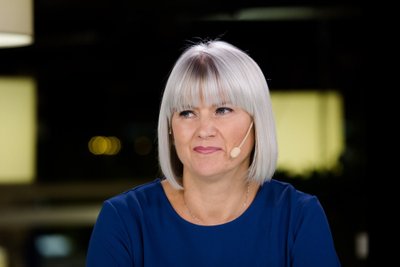More and more children are distracted: how to deal with that
Eglė Kesylienė, head of AMES Education, starts from discussing the conclusions that scientists have made studying the human brain. According to science, concentration of attention is a vital condition for the successful development of cognitive abilities and the development of a child. Based on their findings, guidelines have been developed for how long an average child can concentrate attention on one particular task at different age.
“For example, a two-year-old can concentrate for 4-6 minutes, a five-year-old for 12-18 minutes, a ten-year-old for 20-30 minutes, and a fifteen-year-old for 30-40 minutes. However, our teachers who work with children every day, are quite pessimistic and notice that the concentration time is constantly getting shorter; lifestyle and daily habits are to blame,” says Kesylienė.
Kesylienė admits, that the seriousness of this problem has been highlighted in a recent study conducted by online learning platform Kapow Primary from the Great Britain, where 504 teachers were involved. The results have shown that 84% of teachers do believe that contemporary elementary school children have “shorter attention span than ever before”, so in order to capture and hold children’s attention teachers need to spend less than 10 minutes on each task.

Inevitably, these challenges require new learning strategies. According to Kesylienė, changes in children’s behaviour encourage teachers to constantly look for ways how to educate a modern student, what strategies to apply, but it is complicated. She observes that children always prefer play-based tasks, so it is a real challenge for teachers to interest children in all learning activities, including those that require attention, diligence and concentration, to refocus those who have lost attention and at the same time achieve good academic results.
“Language learning is a very dynamic and demanding process, so it is important to maintain a certain balance between the amount of information, the intensity of its delivery and the individual’s capacity to absorb it at a pace and manner that he or she is comfortable with. Therefore, in class the first thing to do is to create an environment for learning and stay away from distractions, such as mobile phones. In order to avoid monotony, we use a lot of visuals, try to apply novel education methods. During classes, we aim at giving more complex tasks in the first half of the lesson, when the children are ready to learn, but not yet tired, and we also try to balance tasks requiring greater concentration with tasks of a more improvised nature, such as speaking exercises,” Kesylienė explains.
Kesylienė names another nuance when adapting to the peculiarities of modern children’s learning: teachers try dividing the lesson into separate segments, they try individualize the process of learning. According to the expert, in school even “mindfulness” methods are being tested, when additional breaks are made during the class for breathing exercises, deep concentration and search for inner calmness.
What can we do to avoid the attention span from getting shorter?
According to Kesylienė, the problem of holding attention usually does not occur in one day, thus it is highly unlikely to cure it in a day either, but consistent work will definitely produce positive results.

Kesylienė draws parallel between keeping attention on a particular task and doing sports. If during the first visit in the gym even the simplest exercises seem tough, intensive and consistent work with your body help to reach desirable results.
“Children’s attention can be developed from an early age by practicing various specific small tasks – one small step at a time, by clearly stating expectations, also concentration-training games are a helpful tool. With small children certain routine is useful, a sequence of activities, so that the little one would know how the lesson will go and certain habits are acquired,” she explains.
“It should not be forgotten that excellent results could be achieved only with combining effective learning with quality rest and physical activity. Physical activity not only helps to maintain physical health, but also teaches to focus and pursue a goal without distractions – to take a certain action at a specific time and to perform it as well as possible. Believe it or not, it is the best attention training,” Kesylienė says.
Attention problems is not a single issue: hyperactivity is becoming more common
Audronė Stoškienė, English teacher from “Saulė” private high school and head of methodological activities, admits that during the last few decades children’s ability to concentrate and keep attention, concentrate on one particular task and stay in the one particular position for a while (e.g., sitting on their desk for the whole lesson) had been consistently worsening.

According to her, in such cases, teacher and student’s relationships turn complicated, because the teacher, in order to achieve the academic goals, relies on student’s concentration and attention, while some children fail at staying attentive. Thus, conflict situations become inevitable and, as a result, require new solutions.
“First of all, students having attention and concentration difficulties require individual attention. Of course, if the number of students in the class allows the teacher to find some time for everyone, it is possible. But in the cases where there are 30 students or even more, it becomes impossible for the teacher to give attention to each child individually. I work in a school where the largest class is only 17 students. It means, I can see everyone and organize activities accordingly that not only I, as a teacher, but also my students can give assistance to those who struggle concentrating,” Stoškienė explains.
According to the teacher, modern education should be interactive – for example, during Stoškienė’s classes, discussions, group activities or practical sessions take place, they encourage children get involved. Individual activities in the lesson take no more than 10-15 minutes. Often students act as teachers for each other, which helps to avoid boredom and learn effectively without distractions.
She notes the importance of taking advantage of the variety of educational material available online. Various slideshows, videos, interactive learning and testing programs gives the freedom to choose from plenty of teaching methods, they spark children’s interest, helps them to focus and keep attention.
“Games should not be forgotten, either interactive ones like Kahoot or Baamboozle, or the one the teacher organizes. Often, I offer students learning games as a way to diversify the lesson’s activities. Such activities allow me to create a working and stress-free atmosphere in class, maintain friendly connection with my students and achieve the desired academic goals together,” advises the teacher.
Today’s students should be provided with more interactive tasks
Stoškienė notices that, as we live in the age of technology, laptops or tablets on desks are seen as often as notebooks and pens.
“Ideas of sustainability should not only be declared, but also implemented. For my lessons I do prepare interactive tasks – both taken from the Internet and created by myself. Such teaching methods not only saves time, but also is more acceptable to modern students who cannot live without a computer or mobile phone. In addition, the freedom to choose from the variety of tasks allows me to adapt the learning material to the students according to their abilities and needs,” Stoškienė says.

“Better educated and aware parents would notice the peculiarities of their child’s behaviour earlier and seek help on time. It is important for parents to acknowledge the problem and address it rather than deny and hide. In addition, constant communication and cooperation between the parents and teachers are crucial, because a child with such difficulties needs help both at home and at school,” says Stoškienė.
However, the teacher notices that nowadays the society tends to delegate the burden of responsibility for children’s problems solely on schools and teachers.
“If there are any difficulties, the teachers are the first to blame, they are the first to be asked what and why went wrong. Only in very rare cases such questions are given to the parents who are closest to the child and should know him or her best. Children come to school from home environment, and particularly home atmosphere has the greatest impact on their attitudes, beliefs and habits. In school, the teachers are forced to deal with the consequences of different parenting methods, which in most of the cases are to blame for learning problems. Therefore, the education of parents and, at the same time, of the entire society on raising children must be extended and improved. Various institutions and public organizations should help the teachers. The government should also pay more attention, it would help a lot,” says Stoškienė.
Teachers may help, but they will never replace parents: live communication is extremely crucial
Kristina Dikšaitytė, a Lithuanian language and literature teacher at VDU lyceum “Sokratus”, notes that keeping children’s attention for the whole lesson has always been and will always be the greatest challenge for the teachers.
“We do experience time completely different than our students: for them, time in class passes very slowly, and we are always short of time. It would be naive to expect that social media and smartphones in the hands of young children will not have any effect on their attention span, memory, ability to concentrate and speak correctly. For the teachers these changes are more than evident. The more static and monotonous the lesson is, the harder it is for children to learn something,” says Dikšaitytė.
She is convinced: in order to successfully educate children, teachers need two fundamentals: to be interested in what matters to young people, and have the ability to manage the class with mutual respect.
“Teachers often don’t even realize how the lesson turns into a boring monologue, so it shouldn’t be surprising that the students became noisy and can no longer hear anything. Thus, we can choose whether to talk about the decreased children’s attention span, or we can look for the ways how to present the lesson material in such a way that students will not lose attention. There are various learning strategies and teachers’ imagination is very creative,” says Dikšaitytė.

However, Dikšaitytė does not agree with the assumption that the teacher should turn into a clown and simply entertain the children. According to her, the teacher simply has to adapt to the children, to their learning style and to their ability to maintain attention.
“If I see that I’ve lost the students’ attention, I immediately bring them back into the conversation by simply changing the subject. It may be simply a question about their daily life, recent events, but at the same time related to the subject we are learning. Such strategy helps to bring the focus back. The most efficient strategy is constant dialogue with the class, encouraging children to ask questions, speak up, give examples, and give their opinion. The same methods do not work for all classes, as some are able to discuss, but others may be more involved in writing, working in pairs or in groups. The most important thing is to make sure that the students feel part of the process that the teacher creates,” says Dikšaitytė.
When asked what are most efficient methods for solving the problem, the teacher’s answer is simple: as much live communication as possible with the child from an early age.
“Smartphones and cartoons will never replace the attention, warmth and connection with parents, which is extremely important. Parents should spend as much time as possible with their children, involve in many as possible activities together. If you want to get your child interested in reading, set an example – read books together. Watch movies together, discuss them. Help children learn to express themselves, let them make mistakes. Play board games together, find out what computer games they play, try them yourself. Encourage children to be physically active, go for a walk with them, maybe even to the gym. Do not leave children to grow up on their own. Teachers can help a lot, but they will never replace parents,” emphasizes Dikšaitytė.
How to limit technologies: apps may be helpful
It is widely agreed that growing problem of concentration and attention is greatly influenced by the use of smart technologies and time spent with computers, tablets and smartphones. Recently, Tele2 has conducted research on how parents understand the dangers on the Internet and what measures are taken to deal with them. Tele2 public relations manager Asta Buitkutė presented the results on “Delfi diena” program.

But is it really enough to trust your gut when children have had enough of technologies? Buitkutė is convinced that it is not so.
“I know from my own experience, that this is not enough. I’ve tried both talking and saying that maybe enough is enough, but only installed apps helped to see the real situation how much time kids actually spend on the Internet and using specific apps. Naturally, it encourages drawing boundaries, because children really need them, they may not yet be able to tell themselves to stop. This should be seen as a tool for help,” says A. Buitkutė.
She notes that these days there are so many threats to children online that one tool simply cannot ensure safety: it’s important not only to use an antivirus program, but also a password manager and other apps.
“The parental control apps help you limit both the time spent and access to the content. Operators may also ensure some network-level protection, which recognizes unsafe and suspicious links, warns before clicking on them, or filters out some inappropriate content by blocking access. In our study, parents have admitted that inappropriate content is their greatest worry, because they can somehow control the time spent by just taking child’s smartphone, but even in just a few minutes the child may access the content that he or she should not access,” says Buitkutė.
